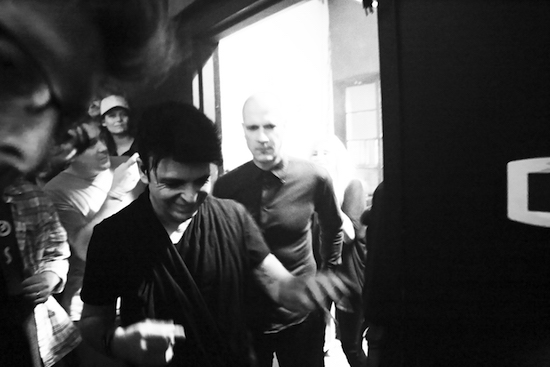The thing about Gary Numan, at least for me, is how often I find myself humming ‘M.E.’, the dark and droney riff famously sampled by Basement Jaxx for ‘Where’s Your Head At?’ A walk down a street can suddenly get soundtracked by a deep-throated hum of those opening synthesizer lines. I found myself doing this in the aftermath of Gary Numan’s second of three gigs at Moogfest. The track has what is perhaps one of the best synthesized openings in electronic history. And to think that the UK music press at the time didn’t understand it is noxiously absurd.
Apart from the notes of ‘M.E.’, Numan’s decades-long tension with music critics was also firmly on my mind at Moogfest, during which he was anointed as a long lost king of synthesis. Not surprisingly, this tension was also clearly occupying his mind when we talked backstage at Durham’s Carolina Theatre. Numan, despite being 58 years old, looked as wonderfully alien as he did back in 1979. There is an otherworldly grace to his current offstage presence, which is quite the opposite of his enigmatic and tortured onstage persona.
In talking to the musician, both aspects seem to originate from his stumbling upon a Minimoog in a rehearsal room back in the late 70s, and feeling then, as well as in later years, that he didn’t particularly know what he was doing with the signfal path. This, combined with having to fight for his musical identity, created an equally confident and sensitive artist.
The current Numan, however, appears to be more at peace with his musical struggle initiated by the Tubeway Army album and its many follow-ups. He is also currently embracing both analogue and digital synthesis. Those who heard his three Moogfest gigs would be hard-pressed to tell the sonic differences between Numan’s songs in their recorded analog format, and their live digital manifestations. Numan himself is blown away by the possibilities of modern synthesis, whether it be analog or digital tools.
But to understand the Numan of the present, it is necessary to go back to the Gary Numan of the Tubeway Army recording sessions. As Numan tells me, his introduction to the synthesizer was an unlikely event. For him, synthesizers were associated with prog rock bands. And even though he was into what Brian Eno, Kraftwerk and David Bowie were doing with electronic music, he didn’t listen to their work and come out the other side wanting to use synthesizers. So the first time he encountered a synthesizer it was quite by accident, not by design.

“I went to a studio to record my first album,” Numan said. “I’d just been signed and I’d written all of these punk songs but my heart wasn’t really in it.”
“So we go to the studio to record our debut punk album, and in the corner of the control room there was a Minimoog,” Numan remembered. “I’d never seen one before. I’m pretty geeky so I was fascinated by it.”
Numan started fiddling with the Minimoog, which he mentally thought of as an extension of his sound generation approach to the guitar.
“I didn’t know how to set the Minimoog up, so I just pressed a key for whatever it was set on, and it made that famous Moog sound, that famous low growl and the room vibrated,” recalled Numan. “It was the most powerful thing. It was like an earthquake and I just loved it. And before the band was even finished setting up the gear I was in there working on changing the songs we’d arrived with into pseudo-electronic songs.”
For him it was a machine that made noise that could be turned into music — well, sometimes. Numan admittedly wasn’t always successful at harnessing the Minimoog’s sonic possibilities. The electronic songs off Tubeway Army, Replicas, The Pleasure Principle and Telekon have a minimalism to them, as if Numan were interested more in simple pop texture instead of exploring analog synthesis’s maximalist potential.
After finishing the album, Numan, “ignorantly” thinking he’d discovered electronic music, took the record, Tubeway Army, to his label, Beggars Banquet. Incredibly enthusiastic about it, Numan thought he had a hit on his hands. Beggars Banquet, however, weren’t so sure. They saw Numan as a punk-pop crossover act, and he had delivered a product that was the exact opposite. After a heated and “silly” meeting, Numan prevailed when the label’s founder Martin Mills decided to let him go for it.
Though the success of Tubeway Army allowed Numan to go even more electronic, he still didn’t own any synthesizers. They were just too expensive at the time. But from then on he wrote some of his songs on an upright piano given to him by his parents. Half of the follow-up album, Replicas, was written on piano and the other half on guitar. Within four or five months of discovering the synthesizer, Numan had a #1 single in the UK charts with ‘Are "Friends" Electric?’, but by his own admission he knew “fuck all about it”.
“The amount of time I’d sat in front of a synthesizer when I had a #1 album could be measured in hours,” he said. “I didn’t own one. I’d rent them for a certain amount of time because I couldn’t afford [to buy one]. They would come to the studio and I’d use them as quickly as I could, and I had no idea what any of the controls did — I just twiddled until it made a noise I’d like. Then they’d come and collect it and I’d never see it again.”
Throughout the 80s, as Numan got pulled along by what he describes as a freight train of fame, the music became confused and, by his own admission, “very aimless”. It was also during this time that Numan de-emphasized the synthesizer, and explored multi-instrumentalism and jazzier sounds. Numan lost confidence, but also his skill at songwriting. After meeting his wife, who pointed out the value in his earlier music, Numan learned to stop hating his output.

With his 1994 album Sacrifice, Numan had found musical direction—industrial rock. For him, the sounds and the then current darker lyrical focus of bands like NIN, took him back to the darker themes he’d explored on his “machine” trilogy of Replicas, The Pleasure Principle and Telekon. But instead of tweaking the analog synthesizers used on those early albums—the Sequential Circuits Prophet-5, Oberheim OBXa and Roland Jupiter-4, amongst others—Numan deployed digital synthesizers like the Alesis Quadrasynth, GEM S2 and Korg Wavestation SR.
“Sacrifice was a really fucking dark record, and it was a turning point for me,” Numan said. “And this is where the second part of my career started. That sort of music is where I’m happiest. And though each album is different from the other, there is still an industrial sort of vibe. I’m really proud of the last one, Splinter.”
Despite the fact that Numan knows his current music is not commercial, that it is not likely to make it on television or the radio, he is content writing the music he wants to write. And as his Moogfest sets illustrated, sonically-speaking Numan is masterful at blending past and present, analogue and digital, with his current hardware and software setup. For Numan’s music, his Access Virus synth can faithfully simulate his older sounds, and deliver the more digital sounds found on albums like Splinter (Songs from a Broken Mind).
“I’ve got presets in the Access Virus for Arp Odyssey, Polymoog, Minimoog obviously, and a few of the quirkier ones along the way,” Numan said. “The Virus is the only machine that I’ve had certainly that is genuinely capable of doing it. It’s a hugely fat, warm-sounding thing. And it blows all of the analogue-digital debate out of the water as far as I’m concerned.”
Numan’s current workflow is a far cry from the day he tweaked and played his Minimoog. While he still writes songs on a piano, Numan designs sound on a variety of analogue and digital hardware. But he has also recently incorporated the Spectrasonic Omnisphere 1 and 2 into his sound design process.
“That is one of the best inventions for human beings,” said Numan. “There is a lot of great software around, virtual synths and such, but I’ve got to say that the Omnisphere for me is just head and shoulders above them all.”
Despite leaning heavily on software and his Access Virus these days, Numan still uses a Moog Voyager. He also plans to implement a new Minimoog Model D, given to him at Moogfest, into his sonic repertoire.
As our chat drew to a close, Numan took a moment to muse, saying, “They’re all great machines”. So unlike the artist who was once lost in the musical wilderness, this Gary Numan, the one who blazed through three magical sets at Moogfest, is clearly looking forward to the future of synthesized, machine sound.



